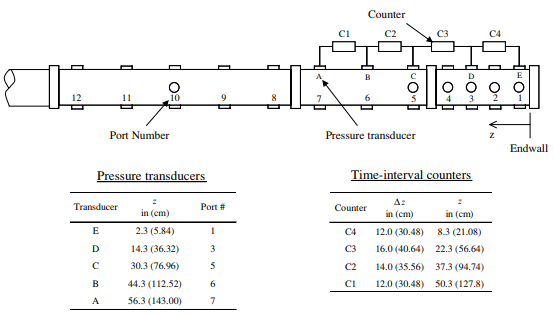The Petersen research group has a longstanding collaboration with The Aerospace Corporation in El Segundo, California which encompasses fundamental and applied research related to gas dynamics, chemical kinetics, and chemical propulsion. This collaboration includes several past and ongoing experiments and projects, and two of these are described herein. Collaborators at Aerospace include Dr. Mark Crofton, Dr. Thomas Curtiss, Dr. Brian Brady, Dr. John Desain, and Dr. Andrea Hsu.
The chemical kinetics shock tube at the Aerospace Corporation (shown below) has a driven section of 10.2 m, has an internal diameter of 15.24 cm, and is heatable up to 200 °C. Test times on the order of 3 ms are possible with reflected-shock pressures up to 100 atm and temperatures greater than 4000 K. Applications for the shock-tube facility include the study of ignition delay times of fuel/oxidizer mixtures, the measurement of chemical kinetic reaction rates, the study of fundamental particle formation from the gas phase, and solid-particle vaporization, among others. The diagnostic techniques include standard differential laser absorption, FM laser absorption spectroscopy, laser extinction for particle volume fraction and size, temporally and spectrally resolved emission from gas-phase species, and a scanning mobility particle sizer for particle size distributions.

Schematic representation of a typical experimental setup of the diagnostic end of the Aerospace Corporation shock tube depicting the location of sidewall pressure transducers, the counter system, and optical ports.
The Aerospace Corporation houses a unique shock-gun apparatus capable of accelerating seeded metallic particles into a target material at high velocity and in a high-temperature, pressure, and oxygen concentration environment to study the material’s ignition and combustion properties. An example set of still frames from an experiment with aluminum particles impacting and yielding combustion of a target material are shown below. The range of potential oxygen fill pressure and driver-to-driven pressure ratio encompasses the ranges of 0.2-6.9 MPa (25-1000 psia) and 25-1300, respectively. High-speed imaging has been used to correlate particle arrival time and velocity (310-700 m/s) at the impact plane to pre-test conditions and particle geometry. Total pressure and Mach number conditions have been directly measured at the particle impact plane using modified inserts, with results spanning the 2.8-15.9 MPa (0.4-2.3 ksi) range. The experimental apparatus is currently being utilized to evaluate novel metal alloys capable of circumventing this potential catastrophic failure mechanism for liquid rocket engines that exploit enriched-oxygen conditions.

Set of still frames from a particle impact tube experiment showing arrival of aluminum particles, particle impact, and subsequent target ignition and combustion. The driven tube exit and impact plane are marked with solid blue and red lines, respectively.
